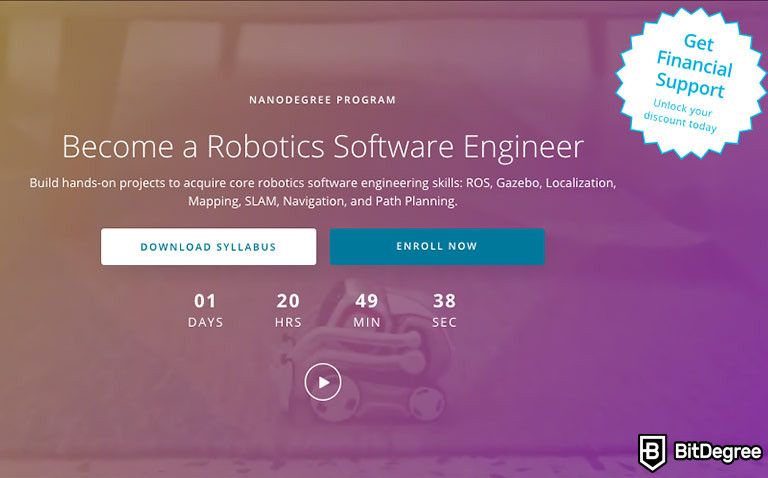Stop overpaying - start transferring money with Ogvio. Sign up, invite friends & grab Rewards now! 🎁
Robotics is a discipline that integrates computer science, engineering and technology. The main goal of robotics is to create machines that would be capable of assisting humans.
Robotics is used in construction, operation, design, and other fields where machines can help people and even completely replace them. It’s a very interesting field, so if you want to find out more about it, Udacity Robotics Nanodegree is exactly what you need.
In this Udacity Robotics Nanodegree review, we’ll take a close look at this program and discuss every detail, including the courses that it consists of, experts that you’ll be learning from, pricing, and additional information that will help you to understand if Udacity Robotics Nanodegree is right for you.
Also, at the end of this review, I will introduce you to a few alternatives to Udacity Robotics Nanodegree and shortly discuss them.
At this point, there’s nothing left to say, so let’s move further and find out more about robotics.
Table of Contents
- 1. What is Robotics All About?
- 2. Udacity Robotics Nanodegree (Enroll HERE)
- 2.1. Skills You Need Before Enrolling
- 2.2. Courses Included In Udacity Robotics Nanodegree
- 2.3. Meet the Instructors
- 2.4. The Perks of Udacity Nanodegree Programs
- 2.5. What is the Price of Udacity Robotics Nanodegree?
- 3. Alternatives to Udacity Robotics Nanodegree
- 3.1. Electricity & Electronics - Robotics, Learn by Building (ENROLL HERE)
- 3.2. Robotics Specialization (ENROLL HERE)
- 3.3. Modern Robotics: Mechanics, Planning, and Control Specialization (ENROLL HERE)
- 4. Conclusions
What is Robotics All About?
As mentioned at the very beginning of this Udacity Robotics Nanodegree review, robotics is an interdisciplinary field that connects engineering, computer science and technologies that are used to design robots. In even simpler words, it’s a study of robots.
Latest DataCamp Coupon Found:The main goal of robotics is to create machines that would imitate human work or completely change it. There have been many interesting theories about robots throughout history. One of them is that robots will be capable of imitating human behavior and perform tasks that are regularly done by people. It’s fair to say that today all of that is possible.

Currently, robots are capable of walking like humans, speaking like us, lifting weights and performing other human-like activities. However, they can not only replicate our movements but also perform tasks that are too dangerous for people.
One of such examples is robots that are designed and taught to defuse bombs, exploring mines, shipwrecks, and finding survivors. Robots can be also used as a teaching aid.
Now, there are many different applications of robots nowadays. Let me give you a few examples:
- Robots in rehabilitation.
- Robots for COVID-19 response.
- Robots in urology.
- Robots for environmental monitoring.
- Robots for nuclear power plants.
- Robots in surgery.
There are multiple other examples where robotics is used nowadays. It’s safe to say that this field is gaining more and more popularity every year, so by enrolling in Udacity Robotics Nanodegree now and constantly improving your knowledge you might become an expert that will change the way we see robotics in the future.
Now that you know what robotics is all about, it’s time to move further and focus on the Udacity Robotics Nanodegree that you came here for.
Udacity Robotics Nanodegree (Enroll HERE)
- Estimated Time: 4 months (10-15 hours per week)
- Price: $1356 ($339 per month)
- Certificate: YES
- Level: Intermediate-Advanced
- Apply HERE
Udacity Robotics Nanodegree is created for everyone who wants to explore the world of robotics software engineering. The program focuses on teaching you not only theoretical knowledge, but you’ll also be learning through the practice of using the ROS framework and C++ to program robots.
Moreover, the major goal of this program is to also provide you with an understanding of robotics software engineering algorithms such as localization, mapping, and navigation, and teaching you how to apply these skills in real-world situations.
Udacity Robotics Nanodegree is quite extensive. You should be able to complete it within 4 months when learning 10-15 hours per week. However, keep in mind that it’s flexible, so you’ll be able to set your own schedule.

Udacity Robotics Nanodegree consists of 6 courses and 5 projects, each of these projects will allow you to put theoretical knowledge that you gained in classes into practice. The completed projects can be easily added to your CV or portfolio to show off your skills to your future employers. Those skills include ROS, Gazebo, C++, Mapping, Localization, Navigation, SLAM, and Path Planning.
There are multiple things that we need to discuss in this Udacity Robotics Nanodegree review, so let’s move to the further section.
Skills You Need Before Enrolling
If you’re interested in robotics and decide to enroll in the Udacity Nanodegree program, there’s one thing that you need to do first - find out if you have the required knowledge to start learning. Even though no one will stop you from doing that, you will probably fail to keep up if you have no idea what instructors are talking about.
Getting back to Robotics Nanodegree, there are some prerequisites and requirements that will increase your chances of succeeding in this program. Here’s the list of the knowledge that you should have before enrolling:
- Intermediate knowledge in probability.
- Intermediate knowledge in calculus.
- Advanced knowledge in object-oriented programming - C++ is the most recommended.
- Intermediate knowledge in linear algebra.
- Basic knowledge of Linux command lines.
As you can see, Udacity Robotics Nanodegree is not suitable for beginners, however, it doesn’t mean that you have to give up on this program, there’s always a way out.
If you lack the required knowledge and skills, you should go for a program that teaches you basics. In this case, it’s recommended to choose the Intro to Self-Driving Cars Nanodegree program.
This program requires minimal skills - to be able to read and modify a code. As the program says it’s “the perfect way to start your journey”. You will learn to apply C++ as well as matrices and calculus in code. What is more, you will improve your Python skills, and learn to solve different problems related to self-driving cars.

After completing this program you will have the needed knowledge and skills to enroll in Udacity Robotics Nanodegree. That being said, even though it takes time and effort, the knowledge you get is much more valuable than that.
Now that you know the requirements for Udacity Robotics Nanodegree, it’s time to move further and take a look at the courses that you’re going to take.
Courses Included In Udacity Robotics Nanodegree
The Udacity Robotics Nanodegree consists of 6 courses and 5 projects. Each of those projects is an amazing opportunity to apply the knowledge that you’ve gained in classes in the real world.
Moreover, you will be able to add all of the projects that you complete to your CV or portfolio to show off your knowledge and skills to your future employers. After all, this is the best way to prove that you have what it takes to become an expert in robotics.
Course 1: Gazebo World
The first course includes only one class, so it will be a shorter one. It will teach you how to build new environments and deploy assets whilst working with the Gazebo simulator. The Gazebo is a simulation engine that’s considered to be the most popular one when it comes to robotics.
This course also includes a project that will teach you how to build your first environment using tools that you’ve learned in Gazebo. Needless to say, even the very first course will teach you applicable knowledge.
Course 2: ROS Essentials
The second course is all about ROS essentials. This course will introduce you to ROS (Robot Operating System) by providing you with an architectural overview. Moreover, it will teach you the ROS workspace structure, the most important command-line utilities and managing software packages. In the final lesson, you will be writing ROS nodes in C++.
This course also includes a project that allows you to demonstrate your knowledge in ROS, C++ and Gazebo by designing a ball-chasing robot. This project is very interesting and will provide you with the additional experience that’s needed in this field.
Course 3: Localization
The third course includes five lessons as well as a course project. It will teach you about Gaussian filters and how they can be used to estimate noisy sensor readings. You will also learn how to estimate a robot’s position.
Moreover, this course will provide you with an introduction to localization as well as the challenges behind it, explain the importance of the Kalman Filter when estimating noisy data, implementing an Extended Kalman Filter package, localizing robots using MCL (Monte Carlo Localization), coding MCL algorithm in C++, and even more.
In the course’s project, you will use such skills as Adaptive Monte Carlo Localization in ROS as well as understanding the needed tuning parameters. The main goal of the project is to teach you how to determine your robot’s position.
Course 4: Mapping and SLAM
This course includes four lessons, you will learn how to create Mapping implementations with ROS packages as well as Simultaneous Localization and C++. All of these processes will be performed by combining mapping algorithms together with the knowledge that you’ve already acquired in this and previous courses of this program.
Just like with all the other Udacity Robotics Nanodegree courses, this one includes a project. This time you will need to know how to use ROS debugging tools such as rqt and roswtf. What is more, you will need to implement SLAM with ROS or Gazebo.
Course 5: Path Planning and Navigation
The fifth course will teach you about different Path Planning and Navigation algorithms. What is more, you will learn how to combine both of them into a home service robot that is capable of transporting objects in your home autonomously.
The project of this course will require path planning, integration of ROS and Gazebo as well as ROS Navigation stack 7 to teach your robot how to move objects in an environment.
Course 6: Optional KUKA Path Planning
The final course will begin with the introduction to your final project, its specifications, requirements and how to get started.
The project will require you to search for a path and navigate a KUKA robot through a 2D maze by applying your knowledge about ROS and path planning. You will also need to use your C++ and Python skills.
While there’s quite a lot of information to grasp, here are the main knowledge and skills that you will learn after completing this Nanodegree:
- Software fundamentals that are needed to work on robotics using ROS, Gazebo and C++.
- Building autonomous robotics projects.
- The knowledge of Probabilistic robotics, including Localization, SLAM, Navigation, Mapping, and Path Planning.
As you can see, there’s quite a lot to learn. So if you’re truly interested in robotics, there’s no reason to wait longer - start learning right now!
Meet the Instructors
Whether it’s a course, specialization or Udacity Robotics Nanodegree, one of the most important aspects to take into consideration is always instructors. When you’re learning from specialists in their field that are also charismatic and have interesting personalities, you will not only gain easily-applicable knowledge but will also spend some great time learning.
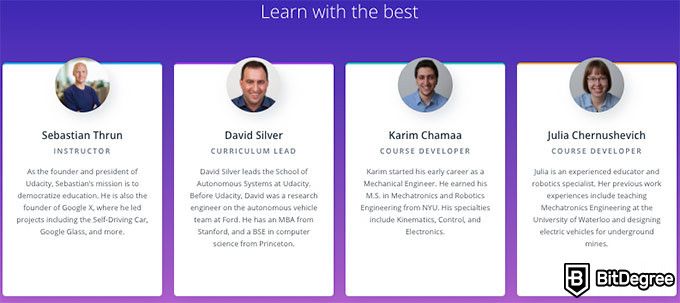
When it comes to Udacity Nanodegree programs, you will always be guided by the experts in their field. Their main goal is to transfer the knowledge that they already have to you. Every Nanodegree tends to have multiple instructors that will guide you through this process.
In Udacity Robotics Nanodegree, you will be guided by four experts, including an instructor, two curriculum leads and a course developer. Let me shortly introduce to you each of them:
- Sebastian Thrun (instructor) - you might know the instructor as the founder and president of Udacity whose main mission is to make online education accessible to everyone. He’s also a founder of Google X, and has been leading multiple projects, such as Google Glass, Self-Driving Car, and others.
- David Silver (curriculum lead) - former research engineer on the autonomous vehicle team at Ford, David is currently leading the School of Autonomous Systems at Udacity.
- Karim Chamaa (course developer) - a mechanical engineer who received his M.S. in Mechatronics and Robotics Engineering from NYU. He specializes in Kinematics, Control, and Electronics.
- Julia Chernushevich (course developer) - an experienced robotics specialist and educator who has been teaching Mechatronics Engineering at the University of Waterloo. She also designed electric vehicles for underground mines.
The majority of customer Udacity Robotics Nanodegree reviews are very positive when talking about instructors. Students are pleased with their learning methods and expertise. Needless to say, you should have one of the best online learning experiences in your life.
The Perks of Udacity Nanodegree Programs
Whether you choose Udacity Robotics, Udacity Deep Learning or any other Nanodegree, you will receive the same perks that ensure you get the best learning experience on this online learning platform.
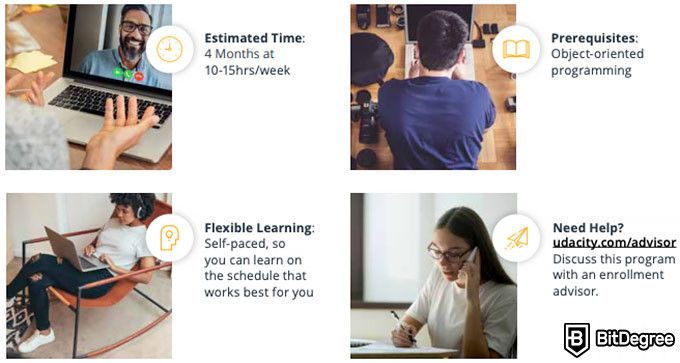
Here are the benefits and main reasons for choosing Udacity Robotics Nanodegree:
- Real experience.
Udacity Nanodegree programs are not only about theoretical knowledge, you will also gain job-applicable skills. Almost every course in the program includes a separate industry-relevant project, so you will put everything that you learn into practice. What you should also know is that you will get personalized feedback that will help you to improve and perform better - more than 900 reviewers are a part of Udacity’s network.
- Access Knowledge.
When I say ‘Knowledge’ I refer to the Udacity wiki where you can easily find answers to your questions. Moreover, you can see what other students were asking and also connect with mentors that will help you solve certain problems.
- Workspaces.
Workspaces are all about testing the quality of the output and codes. That said, if you’re not sure that your code is correct, you can easily test it out and find out.
- Student Hub.
Student Hub provides you with the closest experience to traditional learning as possible. You can easily connect with fellow students, communicate with them, ask as well as give advice, and even get to know them better. It’s always nice to know people that have the same goals as you do.
- Automatically-graded quizzes.
Since Udacity Robotics Nanodegree includes a variety of quizzes, you will be able to test your knowledge and see if every subject was clear. The quizzes are graded automatically, so you’ll be able to see the results in no time. Also, if you want to repeat something once again, you can easily get back to the classes that you’ve already completed.
- Create a custom plan.
Before enrolling in the program, you can create yourself a custom plan based on your current schedule. That will allow you to plan things easier and you will always know when it’s time for your studies.
- Progress tracking.
Progress tracking works like motivation. It includes milestones that will also show you what you’ve already accomplished and what’s still left to be done.
- Learn from the experts.
Even though it was already mentioned in this Udacity Robotics Nanodegree review, I would like to repeat myself once again. If you choose this program, you’ll be learning from the very best experts in the field. And there’s no one that could teach your better than people who have been working in this field for years.
- Learn at your own pace.
There’s one huge advantage that Udacity Robotics Nanodegree has over traditional learning institutions. That’s flexibility. This means that you don’t have to follow a schedule and learn at your own pace, whenever you find the time. That said, you can start improving your knowledge even if you have a full-time job.
- Career services.
Udacity offers access to support and various services that could help you to find your dream job. The services include resume review, LinkedIn profile review, GitHub review, and cover letter review. You will get advice from experts who know what they’re doing, so that should definitely help.
As you can see, there are multiple reasons for choosing the Udacity Robotics Nanodegree program. Since it can provide you with such a great experience, you shouldn’t hesitate and start learning!
What is the Price of Udacity Robotics Nanodegree?
By now we covered almost everything you need to know about Udacity Robotics, however, there’s still one thing that’s left to be discussed - pricing. Let’s see if this program is affordable and whether or not the price is worth it.
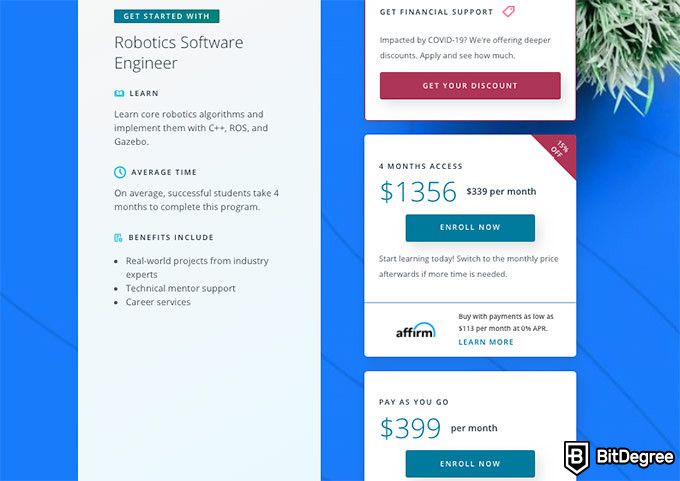
At the moment, Udacity Robotics Nanodegree costs $1356 ($339 per month). You can choose to pay it all at once or pay as you go. If you choose this option it will cost you $399 each month. While it’s a bit more expensive, this option is more flexible.
There’s one more payment option that you can choose from. Affirm Financing allows you to study now and pay later. The payments can be as low as $113 per month at 0% APR. You can pay over 3,6 or 12 months.
Compared to traditional learning institutions, Udacity Robotics Nanodegree is very affordable. Since it provides valuable knowledge and teaches job-applicable skills, I would say that the program is completely worth it.
Alternatives to Udacity Robotics Nanodegree
Udacity Robotics is an amazing option for those who want to gain in-depth knowledge in this field, however, it’s important not to forget that there are always other recommended alternatives.
That said, let’s take a look at some other top-rated courses and programs that can deepen your knowledge in robotics.
Electricity & Electronics - Robotics, Learn by Building (ENROLL HERE)
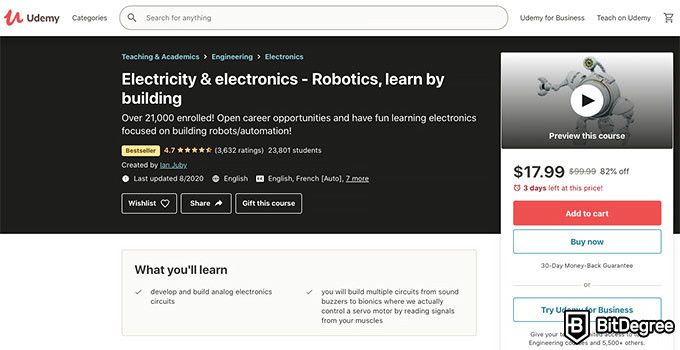
- Platform: Udemy
- Estimated Time: 10.5 hours
- Price: $99,99
- Certificate: YES
- Level: Beginner-Intermediate
- Apply HERE
The first course that’s considered to be one of the better alternatives to Udacity Robotics Nanodegree is offered by Udemy - one of the top-rated MOOC providers. The course is called Electricity & Electronics - Robotics, Learn by Building.
This course is focused on building robots and automation as well as having fun whilst learning electronics. The main goal of this course is to teach you how to develop and build analog electronics circuits. Moreover, it includes the process of building multiple circuits - from sound buzzers to bionics.
The Electricity & Electronics - Robotics, Learn by Building course includes 10.5 hours of on-demand video, 34 downloadable resources and 1 article. Moreover, you get full-time access and a certificate of completion. Keep in mind that this course is flexible, so you can learn wherever you find the time.
The course includes 57 lectures, including DC electricity, AC electricity, using multimeters, resistors, variable resistors, capacitors, schematic diagrams and resistors in parallel, and multiple others.
To enroll in this course, it’s recommended to have at least basic math skills and at least the main electronic tools. All of them will be listed in the very first lesson. If you lack math knowledge then you can always take additional courses on Udemy or other recommended online learning platforms - there are plenty of options to choose from.
Robotics Specialization (ENROLL HERE)

- Platform: Coursera
- Estimated Time: 7 months
- Price: Free for 7 days, then $39 per month
- Certificate: YES
- Level: Beginner
- Apply HERE
Robotics Specialization is recommended for people who want to become experts in robotics. The course will provide you with experience programming robots, motion planning, estimation and programming with MATLAB.
It’s an introductory-level course, so you will begin with the basic concepts, such as robot flight and movement. What is more, you will find out more about how robots understand the surrounding environment as well as how they can navigate and avoid obstacles by adjusting their movements.
Once you understand the basics, the course will explain how robots manage to perform more complicated tasks such as recovery after disasters and construction. You will also be provided with real-world examples to understand how robotics can be applied in different situations, why it’s so beneficial in healthcare and what the future holds for robotics.
The main goal of this course is to teach you how to program a robot to perform various movements, for example, picking things up. Needless to say, this specialization is definitely an interesting one.
What you should also know is that this specialization is an extensive one, so it will take you about 7 months to complete when learning about 5 hours per week. That said, it’s even more in-depth than Udacity Robotics Nanodegree, so you will gain valuable knowledge that’s needed in this field.

- Easy to use with a learn-by-doing approach
- Offers quality content
- Gamified in-browser coding experience
- Free certificates of completion
- Focused on data science skills
- Flexible learning timetable

- High-quality courses
- Nanodegree programs
- Student Career services
- Nanodegree programs
- Suitable for enterprises
- Paid certificates of completion

- A wide range of learning programs
- University-level courses
- Easy to navigate
- University-level courses
- Suitable for enterprises
- Verified certificates of completion
Modern Robotics: Mechanics, Planning, and Control Specialization (ENROLL HERE)
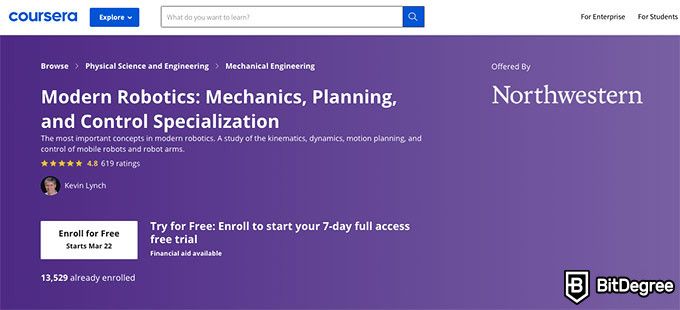
- Platform: Coursera
- Estimated Time: 6 months
- Price: Free for 7 days, then $49 per month
- Certificate: YES
- Level: Intermediate
- Apply HERE
Another course that’s considered to be a great alternative to Udacity Robotics Nanodegree is called Modern Robotics: Mechanics, Planning, and Control Specialization.
Once again, it’s not a course but rather a specialization that’s recommended for intermediate-level students who want to understand the main concepts and gain valuable knowledge in modern robotics.
The specialization includes 6 extensive courses:
- Foundations of Robot Motion
- Robot Kinematics
- Robot Dynamics
- Robot Motion Planning and Control
- Robot Manipulation and Wheeled Mobile Robots
- Capstone Project, Mobile Manipulation
You can also enroll in these courses separately, however, it’s still recommended to take them in the provided order as each of them will teach you the necessary skills to move further.
Now, since the course is recommended for intermediate-level students, you should have previous experience in the related field, otherwise, it might be very difficult to grasp the subjects. What is more, you should be able to complete this specialization within 6 months, when studying about 6 hours per week. After that, you will get a certificate of completion that you’ll be able to add to your CV or portfolio in no time.

Did you know?
Have you ever wondered which online learning platforms are the best for your career?
Conclusions
Robotics is a fast-growing field that is all about designing and studying robots. Nowadays, robots can assist humans, imitate their movements and even completely change them when it comes to automated processes. What is more, robots are used in those situations that are too dangerous for people. For example, exploring mines, defusing bombs, and so on.
Today, robots are helping people in various fields, including medicine, environmental monitoring, nuclear power plants, and so. Who knows how far this field could go in the future.
If you’re interested in robotics and want to learn more about it, Udacity Robotics Nanodegree is one of the best places to begin. It will teach you ROS, Gazebo and C++ that are needed to work on robotics, provide you with the knowledge of Probabilistic robotics, and how to build autonomous robots.

Once you complete the Udacity Nanodegree, you’ll get a certificate that can be easily added to your CV or portfolio. Moreover, since the program includes multiple projects, you’ll gain valuable experience and job-applicable skills.
All things considered, even though the Udacity Robotics Nanodegree seems a bit pricey at first, the knowledge gained is more valuable than that!
If you want to take a look at the alternatives for Udacity Robotics Nanodegree as well, you should consider these courses and specializations:
- Electricity & Electronics - Robotics, Learn by Building
- Robotics Specialization
- Modern Robotics: Mechanics, Planning, and Control Specialization
All of the provided options will teach you in-depth knowledge and skills that will help you to understand more about robotics and move towards becoming an expert in this field.
